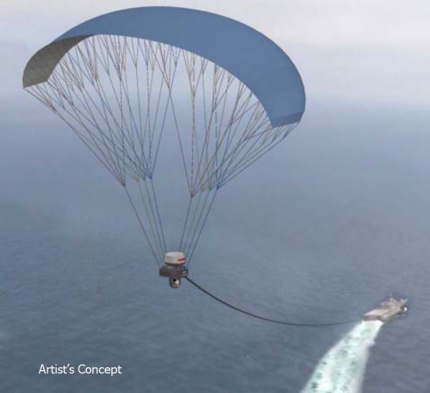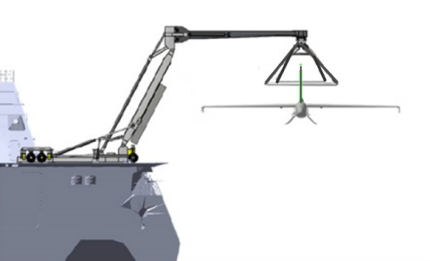UAS-at-sea program produces a couple of practical spinoffs
Offshoots from the DARPA/ONR Tern program could speed up launch and recovery, and boots ships' ISR and communications range.

An artist’s concept of the TALONS parafoil system.
The full story of the Tern program, which seeks to develop long-range drones that can launch from the deck of a ship, has yet to told, but it’s already got a couple of spinoffs.
Tern is a joint project of the Defense Advanced Research Projects Agency and the Office of Naval Research that would boost the ISR (intelligence, surveillance and reconnaissance) capacity of smaller deployed ships by allowing them to host medium-altitude, long range unmanned aerial systems that don’t need a runway. And although the project just recently entered the second of its planned three phases, it has produced two offshoot projects that could, on their own, be put to use in the military.
One of the projects, called SideArm, aims to create a small-footprint crane-like system to enable quick set-up, launch and recover of UAS from ships, trucks or fixed ground facilities. SideArm would be self-contained, portable and capable of launching and retrieving UAS weighing up to 900 pounds. DARPA currently is conducting risk reduction and hardware tests, and plans to soon run a full-scale test involving two different types of aircraft.

Concept shows the idea behind SideArm.
The other project, Towed Airborne Lift of Naval Systems, or TALONS, would improve a ship’s ISR and communications capabilities by towing the equipment with a parasail. TALONS would be an inexpensive parafoil system that could tow payloads weighing up to 150 pounds at altitudes of 500 to 1,500 feet, which would increase that range of the equipment. The agency has already conducted successful ground-based tests and is planning to test TALONS at sea this year.
If the upcoming tests are successful, DARPA could turn the technologies over to the Navy.
“Through SideArm, TALONS and other projects, DARPA aims to make it much easier, quicker and less expensive for the Defense Department to deploy persistent ISR and strike capabilities almost anywhere in the world,” said Dan Patt, DARPA program manager.
NEXT STORY: This is your brain on a computer



